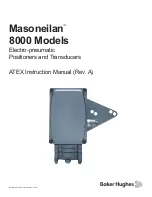
102
MODEL 5081-A
SECTION 15.0
TROUBLESHOOTING
15.2.14 0 OFFSEt
the
-0- OFFSEt
message appears if the standardization offset (in mV) exceeds the programmed limit. the default limit is
60 mV, which is equivalent to about a unit change in pH. Before increasing the limit to make the
-0- OFFSEt
message dis-
appear, check the following:
1. Verify that the reference pH meter is working properly and is properly calibrated.
2. Verify that the process pH sensor is working. Check its response in buffers.
3. If the transmitter is standardized against pH determined in a grab sample, be sure to measure the pH before the tem-
perature of the grab sample changes more than a few degrees.
4. Verify that the process sensor is fully immersed in the liquid. If the sensor is not completely submerged, it may be
measuring the pH of the liquid film covering the sensor. the pH of this film may be different from the pH of the bulk liq-
uid.
5. Check the pH sensor for cleanliness. If the sensor looks fouled or dirty, clean it. Refer to the sensor instruction manu-
al for cleaning procedures.
6. A large standardization offset may be caused by a poisoned reference electrode. Poisoning agents can cause the pH
to be offset by as much as two pH units. to check the reference voltage, see Section 15.13.
15.2.15 CAL ErrOr
CAL ErrOr
appears following a calibration attempt if the new sensitivity is much less or much greater than the value typi-
cally expected for the sensor.
1. Verify that the sensor is properly wired to the transmitter.
2. Verify that the sample flow past the sensor is correct and that no air bubbles are trapped against the membrane. For
recommended sample flows, refer to the sensor instruction sheet.
3. Verify that the membrane is clean. For oxygen sensors being calibrated in air, also verify that the membrane is dry. For
free chlorine measurements using continuous pH correction, verify that the pH sensor is clean.
4. Verify that the laboratory test being used to measure concentrations is accurate.
15.2.16 EEProtECt
Program settings in the 5081-A can be protected against accidental changes by setting a three-digit security code. Settings
can further be protected by removing a jumper (JP-1) from the CPu board. If JP-1 has been removed program, settings
cannot be changed.
15.3 TEMPERATURE MEASUREMENT AND CALIBRATION PROBLEMS
15.3.1 Temperature measured by standard was more than 1°C different from transmitter.
1. Is the standard thermometer, Rtd, or thermistor accurate? General purpose liquid-in-glass thermometers, particular-
ly ones that have been mistreated can have surprisingly large errors.
2. Is the temperature element in the sensor completely submerged in the liquid?
3. Is the standard temperature sensor submerged to the correct level?
















































